Bent's Old Fort
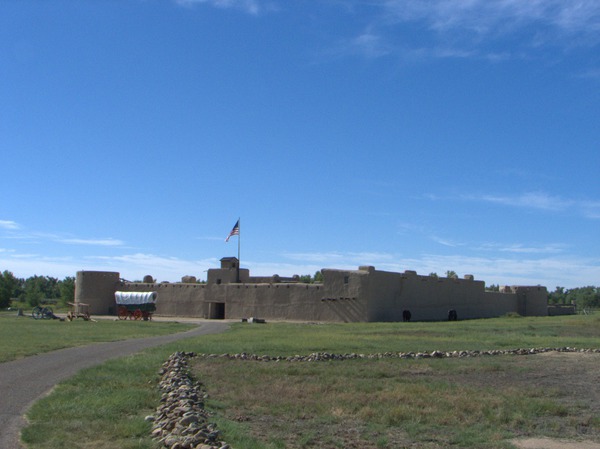
Bent's Old Fort Adobe Stockade -- This is a modern reproduction (1976), which has been immensely useful for filming TV shows portraying the period, such as James Michener's Centennial wherein it represented the adobe stockade of the American Fur Company operation at Fort John, which later became Fort Laramie in what is now Wyoming. The building seen today was constructed over the excavated site of the original fort from as-built floorplans prepared by Lieutenant James Abert in 1846 (U.S. National Park Service, Reconstructing the Castle on the Plains). (Mon 07 Sep 2015 09:51AM, Fullsize 270KB, Map) |
In the late 1820s, William Bent, one of his brothers, Charles, and Ceran St. Vrain from St. Louis pooled their resources to establish themselves in the fur trade on the High Plains and in the Sangre de Christo Mountains of what is now Colorado and New Mexico. They invested inherited wealth. (Wikipedia, William Bent; Wikipedia, Ceran St. Vrain)
By 1845, the firm of Bent, St. Vrain & Company was operating stores in Santa Fe and Taos, Nuevo México, and three fortified trading posts:
• Fort William (ca. 1834) on the Arkansas River, which was -- and is -- popularly known as Bent's Old Fort (Wikipedia, William Bent)
• Fort St. Vrain (1837) to the north on the South Platte River (Wikipedia, Fort Saint Vrain)
• Adobe Walls (ca. 1845) to the south across the Canadian River (Wikipedia, Adobe Walls, Texas)

Weather Stripping -- Note the fur tacked to the hinge-side of the door to keep out the draft. (Mon 07 Sep 2015 10:28AM, Fullsize 284KB, Map) |
Bricklayers from Taos and Santa Fe, Nuevo México, built the forts of adobe from indigenous materials, and all the sites were abandoned by 1849. None of the original structures survive. In various parts of the West, other fur-trading companies operated similar outposts.
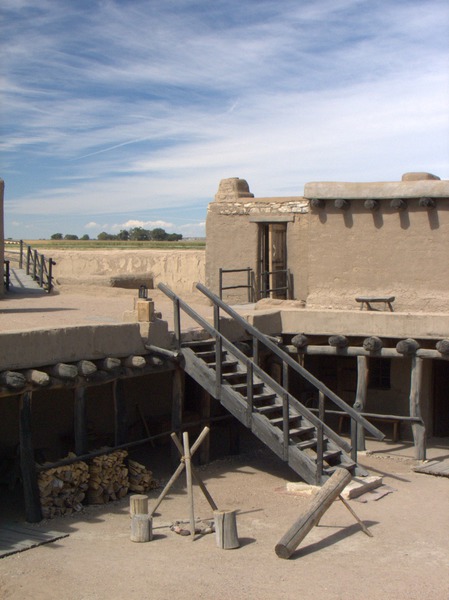
Stairs -- Note the rain gutters on both sides of the top step, which stick through the interior parapet wall. (Mon 07 Sep 2015 10:56AM, Fullsize 305KB, Map) |
In the early days, Bent's Fort was the only settled place on the Santa Fe Trail between Arrow Rock, Missouri, and Santa Fe, Nuevo México. It was positioned to take advantage of the trade along the Mountain Route of the Santa Fe Trail. Also, it was central to the north-south axis of Bent, St. Vrain & Company's fur trade.
Bent's Fort was, thus, a cultural center and even a melting pot. English, Spanish, and French were linguae francae , along with several Indian tongues.

Signal Cannon. (Mon 07 Sep 2015 10:53AM, Fullsize 273KB, Map) |
William Bent's brother Charles was appointed military governor of New Mexico Territory during the Mexican-American War. In his correspondence, he had made no secret of prejudice against Mexicans, Indians (Wroth), and the Catholic Church (Tyler). His bigotry did not endear him to his new constituency -- notwithstanding that his wife was Mexican. He was assassinated at his home in Taos in what was then New Mexico Territory, at the beginning of the Taos Revolt (Wikipedia, Charles Bent").
[Note: Let me apologize again for not having consulted any paper books while preparing this Web page. I might have if my eyes were up to it. Particularly, I did not read Willa Cather's Death Comes for the Archbishop (1927), which I gather casts Padre Antonio José Martínez, el cura de Taos, as a villain. Padre Martínez is one of the most influential characters in the later history of New Mexico, but opinion about him is polarized; he is hardly mentioned nowadays except in glowing panegyrics or else in echoes of Cather's less than laudatory fictional account. Apparently his historical role has undergone recent rehabilitation, and the rivalry between him and Charles Bent has been reevaluated.]
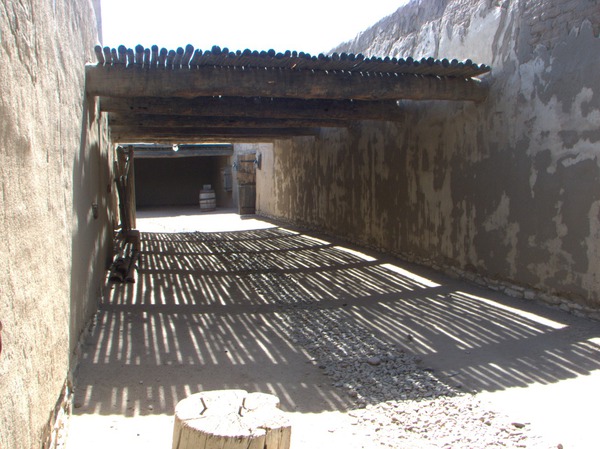
Interior Alley. (Mon 07 Sep 2015 10:32AM, Fullsize 353KB, Map) |
Quelling the Taos Revolt may be seen as an instance of Manifest Destiny backed by commercial interests overcoming parochial interests. In my untutored opinion it is equally well understood as the last triumph of landed gentry over proponents of what we now recognize as Liberation Theology among other events leading up to the Civil War.

Bull Boat -- Among the eye-catching artifacts and reproductions at Bent's Old Fort is this bull boat, a coracle made of the hide of a buffalo bull. These keelless river craft were propelled by single oars, leaving little wake. Probably they were used in pairs for net fishing. Note the tail still attached to the hide. (Mon 07 Sep 2015 10:49AM, Fullsize 510KB, Map) |
William Bent, Charles' brother, had as many as six biracial children by three wives.
Bent's son George was literate in English and spoke Cheyenne, Spanish, Comanche, Kiowa, and Arapaho. He fought for the Confederacy during the Civil War but later (1862?) took the oath of loyalty to the Union. He was present with two siblings at the Sand Creek Massacre in 1864 and testified before two military inquiries and an investigation by the Joint Committee of Congress (representing the northern and the border states) during the aftermath. Those responsible were never disciplined, but such testimony nevertheless prevented the atrocity from being covered up. George rode with the Cheyenne Dog Soldiers during the Indian Wars until he was recruited to work as an interpreter for the U.S. government. He died of influenza in 1918 (Wikipedia, George Bent).
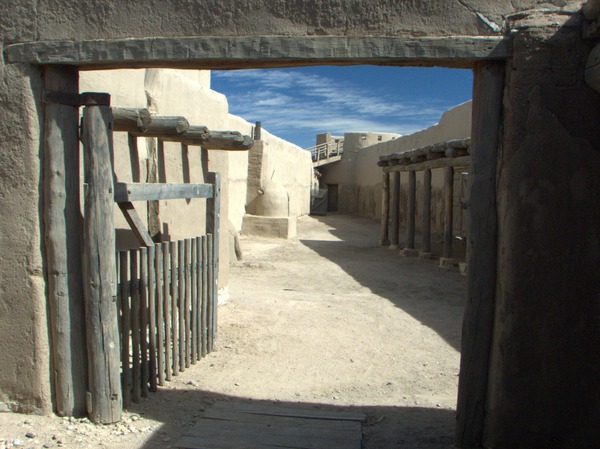
Corral -- This is my Georgia O'Keeffe moment. (Mon 07 Sep 2015 10:37AM, Fullsize 376KB, Map) |
Celebrities drifted in and out of Bent's Fort. The best known among present-day readers is John C. Frémont, the western explorer, who wrote such stirring accounts of his own expeditions to the delight of publishers. He was the first ever Republican Presidential Candidate. He was also an insubordinate Union general. His two guides are famous, too: Thomas Fitzpatrick of the Rocky Mountain Fur Company and Kit Carson, whose renown as an Indian Fighter was promoted in dime novels. The sister of Carson's third wife was married to Charles Bent.
In addition to celebrities, there were personalities who inhabited the fort such as Charlotte Green. Charlotte, her husband, and her brother-in-law were black slaves of William Bent. Charlotte was the master cook. She considered herself a gifted dancer, and contemporary accounts of fandangoes held at Bent's Fort credit her with being the life of the party.
Charlotte's husband, Dick, was in Charles Bent's home in Taos in what was then New Mexico Territory when Bent was assassinated. Dick Green traveled with the Army's punitive expedition from Santa Fe back to Taos and was wounded during the fight to end the Taos Revolt. For this, the Bent family granted him manumission (Wikipedia, William Bent).
%20--%20Bent's%20Old%20Fort,%20CO%20--%202015-09-07%2009:52:56.L.thumb.jpg)
Conestoga Wagon -- Many of the heavier wagons used on the Santa Fe Trail were based on the famous design from the mountains of Pennsylvania. This is a modern reproduction. (The fort houses an original specimen in a dimly lit interior room.) The floorboards were concave to keep heavy freight centered. Seams in the floor, sideboards, and endgates were caulked to turn water during river crossings so cargo would stay dry: hence, the term prairie schooner. (Mon 07 Sep 2015 09:52AM, Fullsize 305KB, Map) |
We know about Bent's Fort from first-hand accounts of such literate adventurers who traveled there as Friedrich Adolph Wislizenus and George Ruxton.
Also, we have second-hand accounts of those who later corresponded with literate inhabitants. Among these are famous historians and anthropologists. Henry Schoolcraft included material provided by Charles Bent in his six-volume study, Historical and Statistical Information Respecting the History, Condition, and Prospects of the Indian Tribes of the United States. George Bird Grinnell authored two books about the Cheyenne. One of them was ghostwritten by George E. Hyde and was based on George Bent's reminiscences. Hyde went on to write a biography of George Bent, which was published in 1968.
The history of the inhabitants of Bent's Fort is, thus, well attested.

Hide Press -- It took between eight and ten buffalo hides to make a 100-pound bale. The hide press was used to compress them into as small a space as possible for transport back east. (Mon 07 Sep 2015 10:30AM, Fullsize 259KB, Map) |
The Stars and Stripes waved here on the north bank of the Arkansas River, which had become part of the United States with the Louisiana Purchase. The land remained unorganized territory until long after Bent's Fort was abandoned.
This flag, which has 27 stars, is a replica of the one adopted after the admission of Florida to the Union in March of 1845. It flew briefly until the admission of Texas to the Union in December (Independence Hall Association).
The river was the dividing line between various political regimes. In Native American terms, the north bank belonged to the Cheyenne, and the south bank belonged to the Comanche (Wikipedia, William Bent).
In Mexican-American terms, the south bank was Mexican territory until Texas won its independence in 1836, after which it was in dispute -- first between the Republic of Texas and Mexico and then between the United States and Mexico after Texas was admitted to the Union in 1845. This dispute was the pretext for the Mexican-American War 1846--1848.
The northern border of Texas was moved south -- away from the Arkansas River -- when New Mexico Territory was organized as part of the Compromise of 1850 (Wikipedia, Territorial Evolution of the United States).
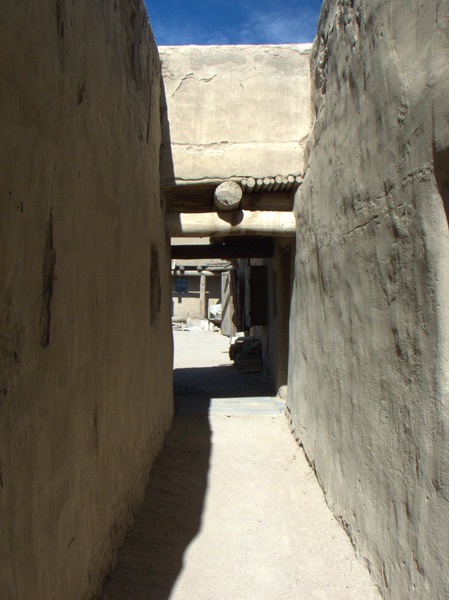
Wooden Beams -- Someone (probably Bent himself) tried to burn down Bent's Old Fort sometime between 1849 (Bent's Old Fort Interpretive Staff, A Self-Guiding Tour) and 1852 (Wikipedia, Bent's Old Fort National Historic Site). As you can see, while flammable materials are structural parts of adobe construction, they are not widely exposed (Wikipedia, Adobe). It is difficult to imagine fire getting much of a start in a structure as large as this or spreading very far. Causing extensive damage would require determination, a lot of accelerant, and perhaps explosives. It may be that Bent was determined. The Arkansas River was no longer the Mexican frontier, and trade over the Santa Fe Trail had mostly shifted to the Cimmaron Route. There was a plague of cholera that occurred coincidentally during the California Gold Rush. Setting the fire may have been an attempt not only to sterilize a contaminated area but also to keep people away. (Mon 07 Sep 2015 10:25AM, Fullsize 318KB, Map) |
Bent's Old Fort was occupied from at least 1834 until 1849. In 1852, its fixtures were salvaged for the construction of Bent's New Fort 55 miles east, and then (perhaps) the old fort was destroyed (Wikipedia, Bent's Old Fort National Historic Site).